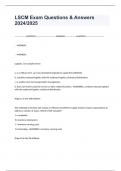Samenvatting
Summary Evolutionary Computing (X_400111)
- Instelling
- Vrije Universiteit Amsterdam (VU)
This is a summary of all lectures used in the course Evolutionary Computing given to students following a master in Artificial Intelligence or Business Analytics. This summary closely follows the book 'Introduction to Evolutionary Computing' written by A.E. Eiben (lecturer of the course) and J.E. S...
[Meer zien]







